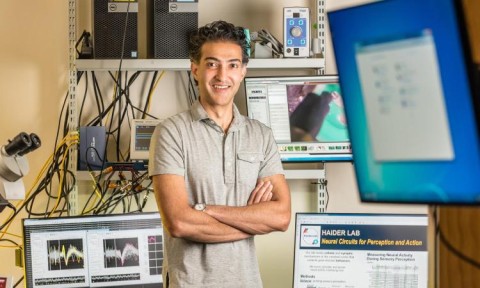
The old one-liner, “he’s too broke to pay attention,” is a fun play on words, but it also has a grain of grim neurological truth.
Because attention does not come easily. The capability, for example, to visually pay attention to one thing and extract critical information while tuning out all else is a complex process involving the work of neurons and circuits across the brain.
“Unfortunately, we don’t know a lot about these underlying mechanisms of attention,” said Bilal Haider, associate professor in the Wallace H. Coulter Department of Biomedical Engineering at Georgia Tech and Emory University. “And that partly explains why we lack effective treatments for various neurological conditions characterized by deficits in attention, and sensory perception.”
The Haider lab is working to close that critical information gap, and the National Institutes of Health (NIH) is supporting the effort through the BRAIN (Brain Research through Advancing Innovative Neurotechnologies) Initiative Award. The three-year, $1.4 million award is administered through the NIH’s National Institute of Neurological Disorders and Stroke (NINDS).
This is Haider’s second BRAIN Initiative award, and it is funding a project entitled, “Tracking Flow of Attention in Visual Circuits Across the Brain,” which is basically a sequel to the lab’s first BRAIN project.
“On the first grant, our focus was on the primary visual cortex in the mouse,” said Haider, whose lab combined electrophysiological, optical, and computational techniques, with unprecedented detail, in transgenic mice that performed visual attention tasks.
The idea was, if they could study and measure higher cognitive functions in a simpler organism they could have a great tool for understanding the mechanisms of attention.
“The current grant will let us go beyond the primary cortex to multiple brain areas, working our way down the chain, tracking attention,” Haider said. “We want to discover how and where these signals of attention are organized and routed. How is it all coordinated and what brain areas need to be involved? Ultimately, long term, the goal is to understand how we can improve attention, and remedy attention deficits in human beings.”
Jerry Grillo
Communications
Wallace H. Coulter Department of Biomedical Engineering
